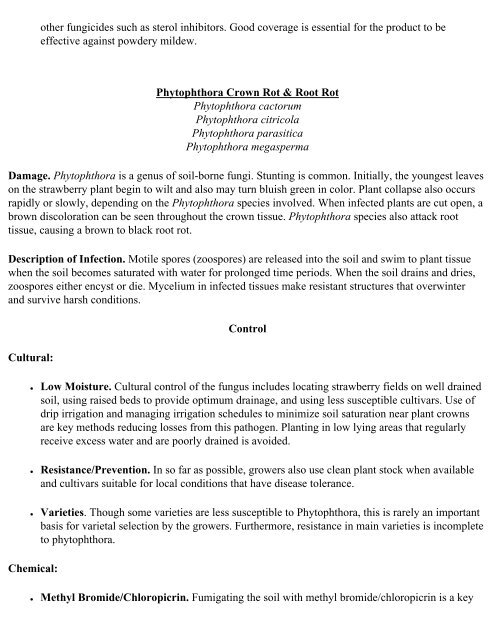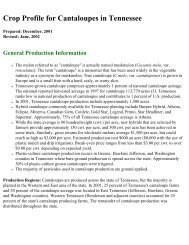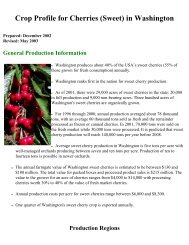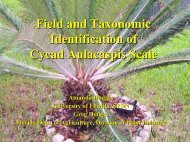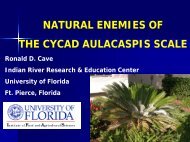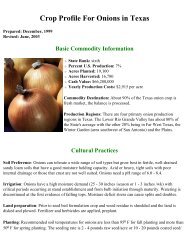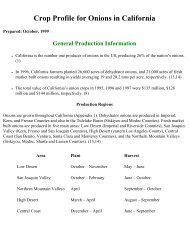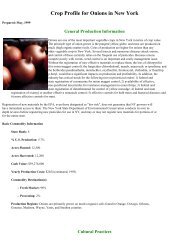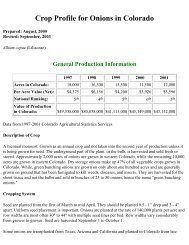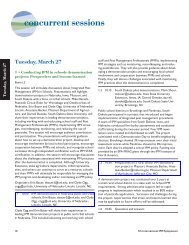Crop Profile for Strawberries in California - Regional IPM Centers
Crop Profile for Strawberries in California - Regional IPM Centers
Crop Profile for Strawberries in California - Regional IPM Centers
Create successful ePaper yourself
Turn your PDF publications into a flip-book with our unique Google optimized e-Paper software.
other fungicides such as sterol <strong>in</strong>hibitors. Good coverage is essential <strong>for</strong> the product to be<br />
effective aga<strong>in</strong>st powdery mildew.<br />
Phytophthora Crown Rot & Root Rot<br />
Phytophthora cactorum<br />
Phytophthora citricola<br />
Phytophthora parasitica<br />
Phytophthora megasperma<br />
Damage. Phytophthora is a genus of soil-borne fungi. Stunt<strong>in</strong>g is common. Initially, the youngest leaves<br />
on the strawberry plant beg<strong>in</strong> to wilt and also may turn bluish green <strong>in</strong> color. Plant collapse also occurs<br />
rapidly or slowly, depend<strong>in</strong>g on the Phytophthora species <strong>in</strong>volved. When <strong>in</strong>fected plants are cut open, a<br />
brown discoloration can be seen throughout the crown tissue. Phytophthora species also attack root<br />
tissue, caus<strong>in</strong>g a brown to black root rot.<br />
Description of Infection. Motile spores (zoospores) are released <strong>in</strong>to the soil and swim to plant tissue<br />
when the soil becomes saturated with water <strong>for</strong> prolonged time periods. When the soil dra<strong>in</strong>s and dries,<br />
zoospores either encyst or die. Mycelium <strong>in</strong> <strong>in</strong>fected tissues make resistant structures that overw<strong>in</strong>ter<br />
and survive harsh conditions.<br />
Cultural:<br />
Control<br />
● Low Moisture. Cultural control of the fungus <strong>in</strong>cludes locat<strong>in</strong>g strawberry fields on well dra<strong>in</strong>ed<br />
soil, us<strong>in</strong>g raised beds to provide optimum dra<strong>in</strong>age, and us<strong>in</strong>g less susceptible cultivars. Use of<br />
drip irrigation and manag<strong>in</strong>g irrigation schedules to m<strong>in</strong>imize soil saturation near plant crowns<br />
are key methods reduc<strong>in</strong>g losses from this pathogen. Plant<strong>in</strong>g <strong>in</strong> low ly<strong>in</strong>g areas that regularly<br />
receive excess water and are poorly dra<strong>in</strong>ed is avoided.<br />
● Resistance/Prevention. In so far as possible, growers also use clean plant stock when available<br />
and cultivars suitable <strong>for</strong> local conditions that have disease tolerance.<br />
● Varieties. Though some varieties are less susceptible to Phytophthora, this is rarely an important<br />
basis <strong>for</strong> varietal selection by the growers. Furthermore, resistance <strong>in</strong> ma<strong>in</strong> varieties is <strong>in</strong>complete<br />
to phytophthora.<br />
Chemical:<br />
● Methyl Bromide/Chloropicr<strong>in</strong>. Fumigat<strong>in</strong>g the soil with methyl bromide/chloropicr<strong>in</strong> is a key


